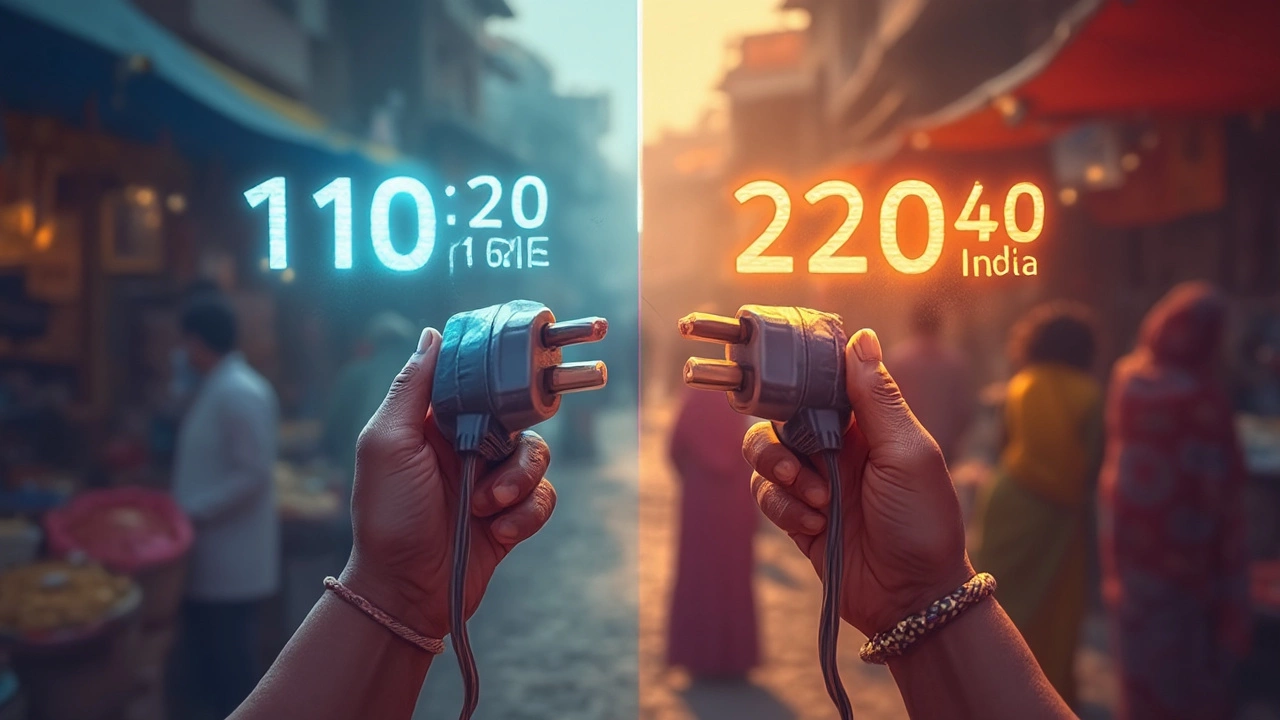 Feb, 28 2025
Feb, 28 2025
When you're packing up your gadgets for a trip to India, it's easy to forget that your US-bought electronics might not just plug and play in a foreign socket. Crazy, right? The first big thing you've got to look out for is the voltage difference. In the US, devices typically run on 110-120 volts. But in India? It’s a whole other ballgame at 220-240 volts. Use something like a hairdryer directly, and you might end up with a smoky surprise.
So, what’s the game plan? Enter the glorious voltage converter. It’s a must-have if you plan to use devices that can't handle the higher voltage. Plus, plug types change too, so you’ll need an adapter. Imagine trying to fit a square peg in a round hole—it's just not happening without a bit of help.
Voltage Differences
Okay, so one of the biggest hurdles with using US electronics in India is the voltage mismatch. In the States, the standard voltage is 110-120V, but in India, devices are powered at a heftier 220-240V. You might be wondering, what's the big deal, right? Well, plug a US appliance directly into an Indian socket, and you risk damaging the device—or worse, causing a fire hazard.
Most importantly, not every device is a happy traveler. Some electronics, like laptops and phones, often come with dual-voltage adapters labeled something like '100-240V.' These are your best travel buddies since they can handle the voltage differences on their own. But watch out for single-voltage devices. These need extra gear to work safely.
How to Navigate the Voltage Gap
Basically, you've got two options to bridge this voltage divide:
- Voltage Converter: A must-have for single-voltage appliances like your favorite blender or electric shaver that simply weren’t made to handle the Indian wattage. This device helps adjust the voltage from 220-240V down to something your gadget can handle.
- Transformer: While similar to a converter, transformers are usually beefier and can handle more power over time. They’re perfect for those heavier appliances you'll use repeatedly.
If you're into numbers, here's a quick peek at global voltage distributions:
| Country | Standard Voltage |
|---|---|
| United States | 110-120V |
| India | 220-240V |
Remember that using US electronics in India isn't just about plugging in and hoping for the best. Prepping with the right tools can save your devices from a meltdown. And, of course, safety first — you don't want any unexpected fireworks!
Plug Types and Adapters
Alright, so let's get into the nitty-gritty of plug types and adapters. The US mostly uses Type A and Type B plugs—those two or three-pronged wonders we're so used to. But in India? It's Type C, Type D, and sometimes even Type M. Yeah, it's a whole different ball game.
Imagine you've just touched down in Mumbai, and the first thing you want to do is charge your phone. You whip out your charger, only to find it doesn't fit. Frustrating, right? That's why packing the right plug adapters is absolutely crucial. These little gadgets are going to be your best travel buddies, transforming your US-style plug into something the Indian sockets can understand.
Choosing the Right Adapter
When choosing a plug adapter, make sure it supports the type of devices you’re bringing along. A universal adapter is usually a safe bet—it covers multiple types and is perfect for world travelers. Just check that it handles the wattage you need, especially for items like hairdryers or electric shavers.
"The most common mistake travelers make is assuming an adapter will change the voltage. It doesn't. It only makes the plug fit," says James Wattson, an expert at Electric Universe.
Now, if you're lugging around multiple devices, you might want to consider a power strip with surge protection. Hook it up to your adapter, and you've got multiple outlets in one.
Adapter vs. Converter: Know the Difference
Before panic-buying the whole electronics store, understand this: an adapter changes the plug shape; a converter changes the voltage. If you're bringing low-power items like laptops or phone chargers, which are often dual voltage, an adapter might be all you need. But for anything else? Probably you'll want a converter too.
Here's a quick look at what you might need:
- For dual-voltage devices: Adapter only
- For single-voltage devices: Adapter + Converter
Being prepared is key here. So check the requirements of your devices and pack accordingly. Trust me, you don't want to be caught short in the middle of an Indian bazaar with a dead phone!

Device Compatibility
You've got your US electronics packed, and you're all set for India. But hold on a sec, not every device plays nice with different voltages and plugs. So how do you know if your precious tech gadgets will survive the trip?
Check Voltage Rating
First off, double-check the voltage rating on your gadget's power adapter. It’s usually printed right there on the back or bottom. Look for something like 'Input: 100-240V'. If it says that, you’re golden! This means your device is dual-voltage and can handle India's higher 220V system. No need for a bulky converter—just a plug adapter will do.
Converters and Transformers
What if your device can’t handle the heat of higher voltage? That’s where converters come in. Light gadgets, like phone chargers, can often work fine with simple plug adapters. But your power-hungry stuff, like blenders or hair straighteners? They might need a step-down converter or transformer to adjust the voltage safely.
But be warned: converters are more like a quick fix. They aren’t meant for long-term use because they could fry your device overtime if it consumes too much power. Best case? You buy the ‘dual-voltage’ versions of travel gadgets whenever possible.
Internet and Connectivity
Aside from power, think about connectivity. In India, the frequency for Wi-Fi networks is similar to the US, so most US devices can hop onto Indian networks without hassle. But be sure your service provider allows international roaming if you're sticking to mobile data.
Be Device-Savvy!
- Always read the labels: Know the voltage limits of your devices.
- Invest in quality: A good quality adapter or converter can prolong your device's life.
- Consider replacements: Sometimes, getting India-ready gadgets from local stores can save a lot of hassles.
- Research before purchase: Check regional brands if you need a long-term solution.
Bottom line, knowing your gear’s compatibility will save you from wrecking your electronics or, worse, a power outage!
Tips for Safe Usage
Diving into the world of US electronics in India can be a bit of a rollercoaster, but don't worry, I've got your back. Safety first, right? Here's how you can make sure your gadgets run smoothly, without going kaboom.
Double-Check Voltage and Power Requirement
First up, always eyeball the voltage and wattage requirements of your devices. Devices like laptops usually have dual voltage capabilities, meaning they can work anywhere with the right plug adapter. But for others? You might need a voltage converter to prevent a blowout.
Invest in Quality Adapters and Converters
Cheap adapters might save a buck, but they can endanger your devices. Aim for good quality adapters and converters that are certified. It’s like buying shoes – if it’s cheap and flimsy, you’re gonna have a bad time.
Be Careful with High-Power Devices
High-power devices like hairdryers and irons are a bit tricky. Using them without checking their capacity to handle India's higher voltage can make them overheat or even break. Consider buying these items locally if possible.
Create a Checklist for Longer Stays
If you're planning an extended stay, keep a checklist. This includes:
- A universal plug adapter that fits India’s Type C, D, and M plugs.
- A reliable voltage converter for non-dual voltage devices.
- Extra fuses for your converter.
- Spare charging cables and power banks.
These all help avoid that “uh-oh” moment when you realize you’ve forgotten something essential.
Watch Out for Power Surges
Power surges can happen and they’re not fun. To protect your devices, consider a good surge protector—it's a little lifesaver when the voltage spikes out of nowhere.
With these tips, your electronics should work just fine in India, keeping you connected and charged up. It’s all about the right prep work, a bit of knowledge, and a dash of common sense.